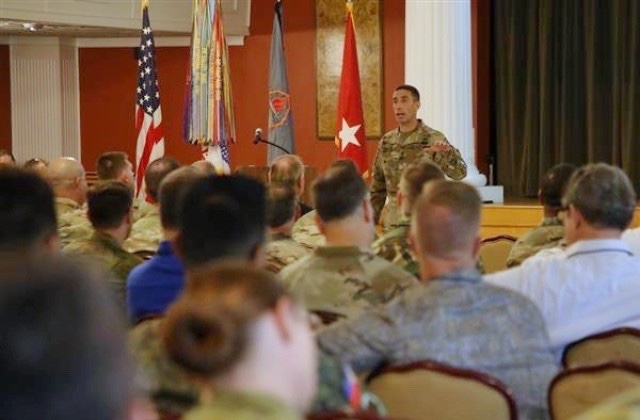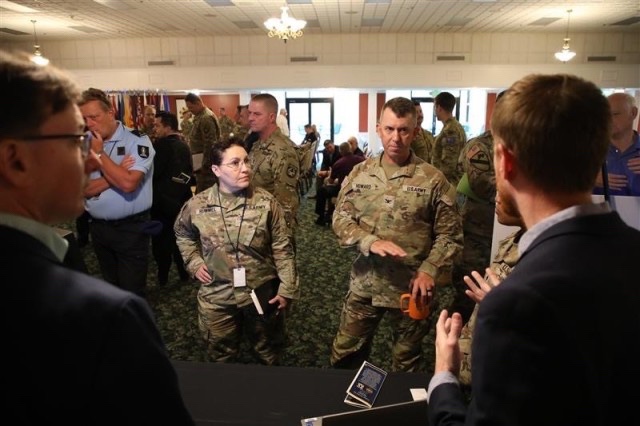FORT GORDON, Ga. — Environment matters when it comes to experimentation and analysis of capabilities for the Army. To determine how a piece of technology will perform on the battlefield, the right environment is needed that replicates many of the battlefield variables.
In the electronic warfare and cyberspace — shortened as EW and cyber — communities, Cyber Quest is that environment. Developed with purpose, Cyber Quest is the perfect place for EW and cyber to experiment and analyze potential technologies that may make their way onto the battlefield one day. It’s where Soldiers, industry and government partners come together for a common purpose — inform capability development in various portfolios including EW and cyber, areas not only critical to the Army but critical to the Program Executive Office, Intelligence, Electronic Warfare & Sensors — known as PEO IEW&S.
This annual prototype assessment, now in its eighth year, explores industry innovations and captures Soldier feedback through a series of rigorous and objective experimentations to provide evidence-based results. Soldiers from the U.S., Australia and Canada took part in evaluating technologies this year.

“Cyber Quest is about making sure the interaction between the science and the practitioners is at the right level,” Maj. Gen. Paul Stanton, commanding general, U.S. Army Cyber Center of Excellence said during his opening remarks. “We take the state-of-the-art capabilities that industry and the scientific community have been working on and we refine them in accordance with what Soldiers tell us they need.”
Anyone within the EW and cyber communities will agree, things move incredibly fast and change constantly. To keep pace, events like Cyber Quest help inform the requirements documents and ultimately increase the rapid acquisition of EW and cyber capabilities.
Members from the EW and cyber requirements and acquisition communities, as well as Soldiers, attend Cyber Quest to see what industry has developed and how those capabilities performed in the experimentations during a culminating distinguished visitors day event.
Due to its focus, Cyber Quest has become the premier prototyping event for the Army, and feeds into larger Army technology assessments like Project Convergence.
From a product manager perspective, “Cyber Quest allows us to see a broader perspective of what’s going on in the [EW] community,” Liz Bledsoe, Product Manager, Electronic Warfare Integration, explained. “There may be technology here we can use in some capacity in the future.”
Beyond the technology results, networking with the community adds even more value to Cyber Quest. “Stakeholder relationships is important at our level,” Bledsoe said. “I met with our Canadian and Australian allies in attendance to catch up and talk shop. We operate alongside both countries often so it’s important we keep those relations up.”
Bledsoe’s work focuses on the Electronic Warfare Planning and Management Tool, or EWPMT, a commander’s tool to remotely control and manage electromagnetic spectrum assets to execute offensive and defensive EW operations. At Cyber Quest, EWPMT was set up to receive data from the participating vendor products and was able to receive data as a result. “Experimentations are great. Any of the data we get from Cyber Quest helps with the future of EWPMT,” Bledsoe explained.

The experimentation aspect of Cyber Quest is fairly unique and can provide the acquisition community a look ahead. “If there’s something really important, we see in the final results, could be positive or negative, it gives us insight on changes we need to make and where can we build the capability up to,” Bledsoe explained. “We may identify aspects the Combat Capabilities Development Command, Command, Control, Communication, Computers, Cyber, Intelligence, Surveillance and Reconnaissance Center or other science and technology organization could work through first and then we can pick up and implement it in two to three years.”
The experimentation component of Cyber Quest 23 also drives home an increasingly important aspect of software development — Soldier feedback matters.
“If you want good Soldier feedback, you have to show you value it in the first place by quickly integrating feedback into the next iteration of a product,” Bledsoe said.
She hopes to be able to take data from the experimentations and Soldier feedback back to her team to help them further develop and improve EWPMT.
“This community is at the nexus of the science and the practitioners, new protocols, new kit, new antennas, new algorithms — aligning with our Signal, EW and Cyber Soldiers – this is our time at Cyber Quest to make sure things work,” Stanton explained. “What we’ve done here at Cyber Quest informs future requirements and capability drops that we hand off to our Acquisition community to buy and build the equipment that’s going to work the way we need it to. It does us no good to give Soldiers a piece of kit that is not going to function under the extreme circumstances of the operating environment.”
By Shawn Nesaw

